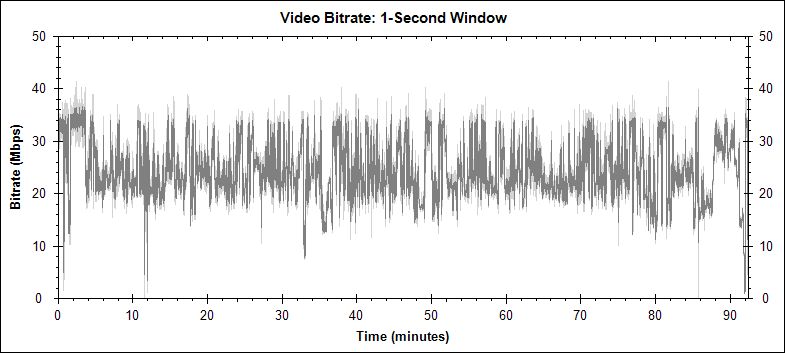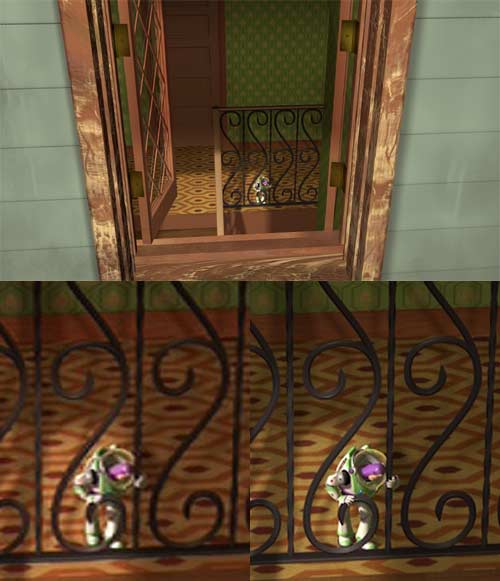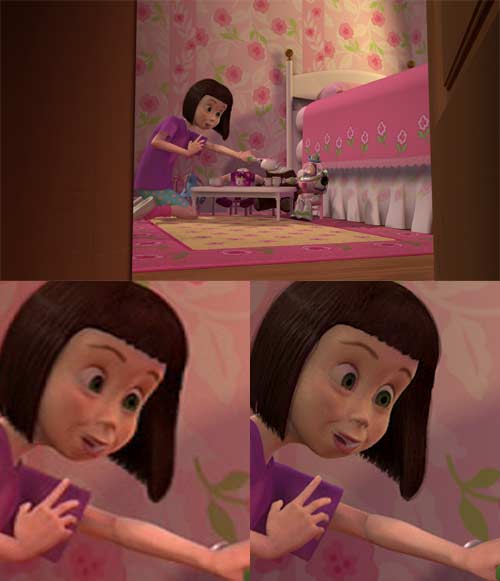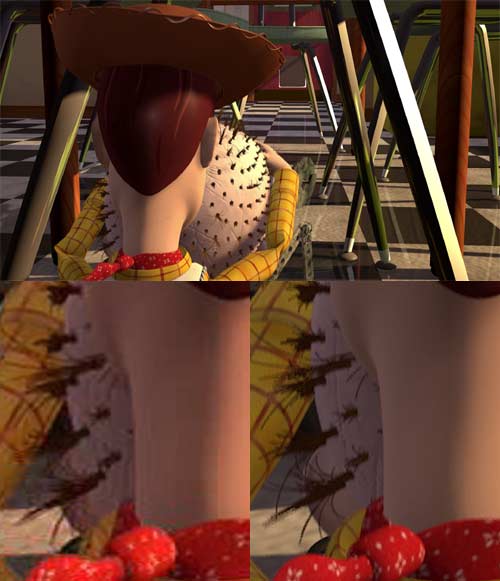 Picture:
Picture:  Sound:
Sound:  Extras:
Extras: 

Movie:  Picture:
Picture:  Sound:
Sound:  Extras:
Extras: 
Movie:  Picture:
Picture:  Sound:
Sound:  Extras:
Extras: 
Yet Pixar has seen itself as a story teller first, with the technology merely being its canvas and paintbrush. Which goes a long way to explain why, now that it has just released its eleventh feature film (fittingly, Toy Story 3), nine of them reside in the Internet Movie Database Top 250 list.
Including all three of the Toy Story movies.
Playing Toy Story for the first time in several years, and certainly for the first time in high definition, I was expecting the Pixar animation to be a little clunky. But I was wrong. Making advertisements and shorts, the company knew its technology, and while it made sure to use the tech to its limits, it didn't step beyond them. So the technological limitations are invisible because Pixar simply made sure it used its technology appropriately.
What you get is perfect geometry, a generally quite realistic appearance of contact between elements, and sometimes a startlingly realistic appearance of synthetic objects (buildings, furniture, carpets). What was to come in later Pixar productions, but apparently not ready for Toy Story, were more aggressive indications of distance through focus and atmospheric haze, and modelling of natural objects. Toy Story 2 is more developed in this regard, but perhaps held back a little by the need for a family resemblence to its predecessor.
All this is presented for both movies in 1.78:1 picture frames. Shown originally at the cinema at 1.85:1, Pixar has simply set the output of their computers to render the picture to use every pixel of a 1,920 by 1,080 pixel frame. And because the whole thing was direct from one digital medium to another, there was no possibility of film artefacts. Disney has used the MPEG4 AVC compression standard at around 24Mbps for both movies. This is a high enough bitrate for high quality reproduction of regular film, which is full of random grain. Compression of these computer generated movies was a doddle at this bitrate. The image on these Blu-ray discs is a perfect representation -- up to the limits of full high definition resolution -- of the contents of Pixar's computers.
Speaking of those contents, it's well worth watching the short featurette on the Toy Story 2 Blu-ray: 'Studio Stories: The Movie Vanishes'. Scary.
1995 was not long after discrete multichannel sound made its way into the cinema, first as Dolby Digital and later as DTS. These movies both get DTS-HD Master Audio-ES Matrix 24/48 sound. This is losslessly compressed, with a surround rear channel mixed into the regular surround channels. In both cases the surround mix is aggressive and involving. At times the subwoofer gets a decent workout as well with some rather deep and powerful content. Despite coming from the 90s, both have first rate 21st century sound.
Toy Story has a significantly higher average bitrate than the second installment -- over 400kbps more, or most of a full Dolby Digital track. My theory is that there was more low level noise on the older movie. Random noise is unpredictable, so it doesn't compress well -- indeed, at all -- in lossless compression systems. Both offer 24 bits of resolution, of which six or eight bits is probably used solely for noise.
Each disc carries the full set of bonus features most recently available on the DVD versions. Indeed, you also get the DVD in the box (useful if you have a car DVD player or whatever). There are also some additional full HD featurettes.
Disney has never implemented bookmarks on its Blu-ray discs, despite them all being loaded with BD-Java control. This disc is no different. But the main drawback of BD-Java is that a player loses a lot of its own control over a disc thus enabled, and a casualty of this is the inability to resume at the point at which playback was previously stopped. Instead, the player must start from the beginning and re-load the BD-Java code.
This disc overcomes this by poking the main feature location in the player's persistent storage if you stop playback part way through the feature. Then after it stars up and while it is displaying the main menu, it asks 'Would you like to continue where you left off?' With this, bookmarks aren't needed.
Anyway, if you want your disc collection to have any pretensions at all of being reasonably complete, at the very least it must include Toy Story. Fortunately, this is not only an imporant movie, but also a very good one.
 (Australian rating); Region Free
(Australian rating); Region Free
The following video bitrate graph was generated by BDInfo 0.5.3:

 (Australian rating); Region Free
(Australian rating); Region Free
The following video bitrate graph was generated by BDInfo 0.5.3:

Here are some comparisons between the Australian PAL DVD and the Australia Blu-ray version of Toy Story. The Blu-ray was supplied to me by Walt Disney Studios Home Entertainment. The PAL DVD is the version included with the Blu-ray.
At the top of each is the full frame (suitably shrunk down) used in the comparison, with a 250 pixel wide detail from the frame underneath. The left side is from the PAL DVD. The image was captured digitally from the disc, scaled up from its native 720 by 576 pixel resolution to 1,024 by 576 (to present in the correct aspect ratio) by the application. I then scaled it, in order for it to be comparable to the Blu-ray version, to 1,920 by 1,080 pixels.
The detail is from that last scaled version, and has not been rescaled again. The right side is from the Australian Blu-ray. This has not been scaled at all. Different applications were used to capture the two frames, so some caution should be exercised in judging colour and brightness.
For visitors from NTSC lands, generally the PAL DVD is just a touch sharper than the NTSC DVD.
Incidentally, while I am strongly promoting Blu-ray, I have to say that the PAL DVD version of this movie offers picture quality that is, I think, as good as PAL DVD can get. Despite this, the loss of detail is marked in comparison to the Blu-ray:


Textures are things that tend to get smoothed over by the lower resolution of DVD. They are clearly more tangible here, not just the stippling but also of the green-coloured wood above it:

Looks like something caught out the compression of the DVD on this frame. There's posterisation (back of Woody's neck) and random compression noise all over. This is a fast moving scene, so perhaps that was it:


